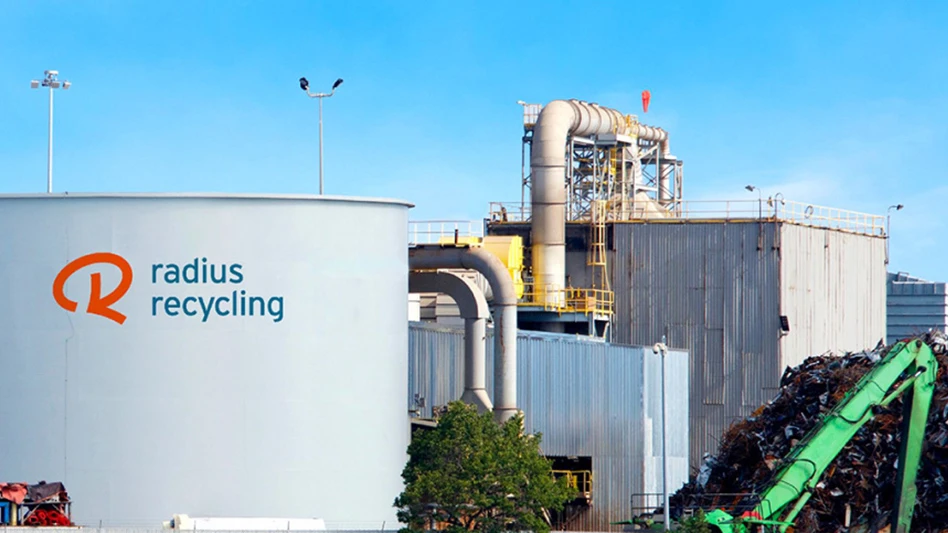After a year of upward momentum, scrap processors had to contend with ferrous inventory that lost some value in the September buying period.
A hectic summer’s worth of supply combined with tepid overseas demand and domestic mill buying that has plateaued brought downward price pressure to the ferrous scrap market.
The steel industry received attention in the wider financial press in late summer, with output cutbacks in China (by far the world’s largest steel producer) putting downward pressure on the price of iron ore globally and finished steel in much of Asia.
Flattening steel production patterns contributed to Fastmarkets AMM Midwest Index prices in early September that saw prime busheling scrap drop from roughly $650 per ton in August to about $600 per ton in September.
Contrary to the prevailing trend of the previous two decades, output in China declined in July, while production in the rest of the world increased. Figures collected by the Brussels-based World Steel Association showed China with July production of 86.8 million metric tons, down by more than 7 million tons from the June figure of 93.9 million metric tons.
A government effort to reduce carbon emissions has been cited as the predominant reason for the steelmaking decline in China. Economists are keen to determine whether a retreat from the massive infrastructure spending and apartment tower building of the previous two decades also could be contributing to a steel slowdown.
In the run-up to the early September mill buying period reflected in Fastmarkets AMM surveyed pricing, weekly U.S. steel output measured by the Washington-based American Iron and Steel Institute (AISI) portrayed an industry in which the revival from previous COVID-19-related woes could be sputtering.
AISI says U.S. raw steel production in the week ending Sept. 4 checked in at 1.866 million tons, which is down 0.4 percent from the previous week, when production surpassed 1.873 million tons. In the first two weeks of August, U.S. weekly raw steel production also fell by 0.2 percent compared with the week before.
The flattening production patterns contributed to Fastmarkets AMM Midwest Index prices in early September that saw prime busheling scrap drop from roughly $650 per ton in August to approximately $600 per ton in September.

Obsolete grade prices also dropped in September, with shredded scrap losing about $10 per ton in value and No. 1 heavy melting steel (HMS) declining by about $20 per ton in the Midwest.
The fate of obsolete grades was not helped by skittish behavior from overseas buyers in August and early September. That trend might have started reversing in mid-September, with the Davis Index news service reporting that buyers in India and Bangladesh were beginning to bid up imported HMS and containerized shred prices (though Davis Index indicates the Turkish market remained soft).
Also offering better news to ferrous scrap dealers is the relative strength of the domestic steel sector compared with last year. Despite a mild downtrend in late summer domestic steel output, the sector remains well-ahead of its pace in 2020, when COVID-19 disruptions caused mill output to plummet.
Production the week ending Sept. 4, 2020, was 1.51 million tons, representing 23.5 percent less output compared with the comparable week this year. In early September 2020, the mill capability (capacity) utilization rate was 67.4 percent compared with 84.5 percent in early September this year.

Ferrous scrap prices going forward remain tied to the prospects for the U.S. economy, including the steel-absorbing automotive and construction sectors.
The auto industry continues to suffer from a lack of access to the microchips used in increasingly computerized car and truck models. Toyota Motors announced cutbacks in North America in August and September, delaying the assembly of about 150,000 vehicles. Argus Media calculated, in a mid-September news item, that since the average North American vehicle consumes nearly 1 ton of steel, per AISI, the Toyota cuts could mean some 250,000 tons of steel that otherwise would have been consumed will not be needed.
Ford Motor Co. has reported a 33 percent decline in sales in August 2021 compared with August 2020, based not on falling customer demand but on a lack of fully assembled vehicles to deliver.
The construction sector, which is less affected by the global microchip shortage, instead is expressing frustration with trends in the domestic metals market.
The Arlington, Virginia-based Association of General Contractors of America, in a mid-September email, cites its producer price index, which shows that steel mill products have increased by 123 percent in price compared with last August, while copper, brass and aluminum product prices have risen by from 35 to 45 percent.

Explore the October 2021 Issue
Check out more from this issue and find your next story to read.
Latest from Recycling Today
- Steve Levetan to receive ReMA Lifetime Achievement Award
- ReMA, Germany’s VDM issue joint tariff statement
- Singapore EAF melt shop idled
- LME reports healthy trading volumes in Q1
- Hyundai adds dealer in Wisconsin
- Study finds recycling symbols largely recognizable
- Reworld announces executive leadership transitions
- Longtime paper industry veteran announces retirement






